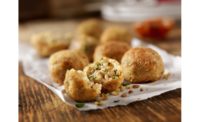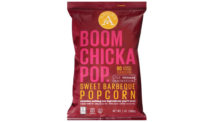Frozen foods can boost sales through healthy, flavor-forward innovation






In select spots across the freezer case, sales are heating up—despite consumer trends that seem at odds with growth. “We have seen a significant consumer migration from center aisles and frozen to the perimeter of the store, where products are perceived as fresher and better for you,” says Agnes Lapinska, senior marketing manager of performance specialties and savory, Ingredion, Westchester, IL. But innovation in the freezer case is pulling consumers back, she says, and sales are rising as a result.
According to data from IRI, Chicago, for the 52 weeks ending November 5, 2017, dollar sales in the frozen appetizer and snack roll segment grew 5.11 percent to $2.1 billion. Category leaders include General Mills, up 2.51 percent to $562.2 million, and Ruiz Food Products, up 21.82 percent in to $245.4 million.
Dollar sales of frozen pretzels rose 1.99 percent since the previous year, with segment leader J&J Snack Foods Corp.—which acquired artisan pretzel and bread baker Labriola Baking Co. in August 2017—up 4.50 percent to $58.2 million. Hanover Foods Corp. also posted growth, up 12.46 percent.
Frozen breaded vegetables dropped 9.42 percent to $26.9 million, but segment leader Pictsweet saw strong growth, up 25.31 percent to $9.8 million.
Frozen pizza, led by an impressive 16.27 percent gain in private label, grew 2.24 percent to $4.7 billion. Other standouts included Schwan’s Co. brand Tony’s, up 22.40 percent to $89.9 million and Nestlé brand Stouffer’s, up 16.24 percent to $65.1 million. However, frozen pizza crusts and dough fell 4.16 percent to $18.7 million.
The key to success? Elevating the frozen-food experience to rival that of a home-cooked or even a restaurant experience. “Quality, flavor and overall appeal have always been important in frozen foods. It’s just the bar for judgment continues to be raised by consumers as they become more experiential regarding food—i.e., seeking exciting food experiences—and the overall food marketplace continues to elevate what it can offer,” explains Jordan Bate, associate brand manager, Lamb Weston, Eagle, ID.
Elevating quality, meeting trends
“The explosion of fresh prepared foods has challenged frozen food manufacturers to provide convenient meal solutions that are as close to fresh as possible,” says John Toaspern, chief marketing officer, Potatoes USA, Denver. “Processors are rising to the challenge by improving the quality of the raw ingredients used, ensuring optimal freshness and flavor.” By using the highest-quality ingredients, frozen foods can compete with fresh offerings on natural and processing trends, while winning the race on convenience and year-round availability.
“Fresh ingredients are the key,” says Tryg Siverson, chief operating officer of Feel Good Foods, Brooklyn, NY. “They always have and will continue to be.” He also notes that it’s important to help deliver a unique experience for the consumer.
Lamb Weston helps tell a story with its new Grown in Idaho brand of frozen potato products. The bags feature prominent “Grown in Idaho” branding.
At Ruiz Food Products, Inc., Dinuba, CA, real, definable ingredients help elevate the brand’s frozen offerings. For example, its El Monterey Simply Breakfast Egg, Turkey Sausage, and Cheese Breakfast Burrito is made with real scrambled eggs and fresh-baked whole-grain tortillas, clocking in at 11 grams of protein and just 220 calories. “As we look at today’s consumer preferences, I believe it is important to note that one of the reasons for our brand’s growth is the desire for options that are healthy and offer energy,” says Rachel P. Cullen, president and CEO.
Nesha Zalesny, technical sales manager, Fiberstar, Inc., River Falls, WI, has noticed increased demand for plant-based offerings. “This is not just meat-analogue products that can be used to replace meat in traditional dishes, but entire entrées centered around vegetables,” she says. One example of this trend in action is the rise in cauliflower products like cauliflower pizza crusts. Jennifer Stephens, vice president of marketing, also notes a rise in demand for healthy ingredients like ancient grains, tempeh and quinoa in frozen items.
As is the case across the food industry, clean label is important in the freezer case. “Increasingly, consumers want to know how ingredients were produced,” says Pam Stauffer, global marketing programs manager, Cargill, Minneapolis. As a result, product developers have moved away from ingredients like modified starches, which have previously played critical roles in frozen food applications but have come under scrutiny in recent years for clean label consumers. Cargill’s SimPure line of functional native starch solutions, launched in fall 2017, specifically addresses this issue. They can replace modified starches in frozen foods and withstand up to 12 freeze/thaw cycles.
On the dough front, Cargill also offers premium lecithins combined with select enzymes, which can produce loaves “nearly indistinguishable” from those made with common dough conditioners and emulsifiers like DATEM and monoglycerides, says Bill Gilbert, certified master baker and principal food technologist.
Going further with flavors
According to Siverson, ethnic flavors continue to be a driver for this space, as they are for many products across the industry.
“There’s an entire world of cuisine manufacturers can introduce to consumers,” says Zalesny. “Indian flavors are becoming more common, but African cuisines have not yet been brought to the mass market.”
If you ask Peggy Castaldi, marketing director, SubHerb Farms, Turlock, CA, one way to elevate frozen flavors is to focus on regional flavors. “For example, consumers aren’t just looking for Mexican,” she says. “They are looking for foods from the Yucatan or from Baja.” Along these same lines, brands can explore flavors specific to different South American cuisines, like those from Peru, Bolivia or Ecuador, or specific Asian flavor profiles like those from the Philippines, Singapore or Malaysia.
In August 2017, SupHerb Farms introduced three new culinary pastes: S’chug, Chermoula and Aji Pesto, along with a Tabbouleh Starter blend. Adventurous eaters will flock to these offerings, but to appeal to the wider consumer base, these flavors make sense in familiar formats. “You can use S’chug, a Yemeni hot sauce, as a sauce for a breakfast sandwich, in a potato dish or on a flatbread,” Castaldi suggests.
Looking ahead
For frozen foods to truly compete, brands may be wise to take a page from the playbooks of ready-to-cook delivery services like Blue Apron, says Zalesny.
Why? As Bate points out, continued growth of online, pickup and delivery services opens the doors for frozen to win back eating occasions from traditional restaurants.
“Have the majority of ingredients prepped and ready to finish cooking and customized by the consumer,” Zalesny says.
Alternatively, frozen brands can win these types of consumers by offering frozen foods with little preparation needed. “Many consumers are on the go, and are looking for easy dinners to serve,” says Tom Mac Donald, vice president of sales and marketing, Brolite Products, Streamwood, IL. “They want variety and healthy options that are prepared and ready for them, and they don’t want to sacrifice any flavor. It has given the freezer aisle an excellent opportunity to grow, expand their selections to include these types of meals, and get creative in their packaging and marketing.”
But what should be included in these new offerings? Stephens suggests that vegetarian meats, which are often sold as standalone individual items, will attract not just vegetarians, but also carnivores open to trying something new. “Because meals contain multiple components, the acceptance rate of vegetarian meats may be higher than consuming alone,” she says.
Frozen pizzas or breakfast burritos prominently featuring vegetarian meats could attract attention from healthy-leaning shoppers seeking better-for-you options.
“The modern consumer is very health-conscious and will look for those options that most closely resemble a fresh, homemade meal,” says Mac Donald. “Manufacturers can bring life to the freezer case by using frozen ingredient technology, so products come out of the freezer with a fresh, attractive appearance and flavor to follow. It’s time for innovation. Thinking outside the box is no longer a luxury, it’s a means of survival.”
Looking for a reprint of this article?
From high-res PDFs to custom plaques, order your copy today!








